class: inverse, middle, center <style>.xe__progress-bar__container { top:0; opacity: 1; position:absolute; right:0; left: 0; } .xe__progress-bar { height: 0.25em; background-color: #808080; width: calc(var(--slide-current) / var(--slide-total) * 100%); } .remark-visible .xe__progress-bar { animation: xe__progress-bar__wipe 200ms forwards; animation-timing-function: cubic-bezier(.86,0,.07,1); } @keyframes xe__progress-bar__wipe { 0% { width: calc(var(--slide-previous) / var(--slide-total) * 100%); } 100% { width: calc(var(--slide-current) / var(--slide-total) * 100%); } }</style> <style type="text/css"> .pull-left { float: left; width: 44%; } .pull-right { float: right; width: 44%; } .pull-right ~ p { clear: both; } .pull-left-wide { float: left; width: 66%; } .pull-right-wide { float: right; width: 66%; } .pull-right-wide ~ p { clear: both; } .pull-left-narrow { float: left; width: 33%; } .pull-right-narrow { float: right; width: 33%; } .small123 { font-size: 0.80em; } .large123 { font-size: 2em; } .red { color: red } .xsmall123 { font-size: 0.60em; } .pull-center { margin-left: auto; margin-right: auto; width: 50%; text-align: left; } .pull-center-narrow { margin-left: auto; margin-right: auto; width: 30%; text-align: left; } </style> # Tracks to Modernity ## Railroads, Growth, and Social Movements in Denmark ### Tom Görges, TU Dortmund University ### Paul Sharp, University of Southern Denmark ### Christian Vedel, University of Southern Denmark ### Magnus Ørberg, University of Copenhagen #### *Updated 2025-07-28* **Email:** <christian-vs@sam.sdu.dk>; **Twitter/X:** [@ChristianVedel](https://twitter.com/ChristianVedel); **BlueSky:** [@christianvedel.bsky.social](https://bsky.app/profile/christianvedel.bsky.social); **GitHub:** [github.com/christianvedels/Tracks_to_modernity](https://github.com/christianvedels/Tracks_to_modernity); **Paper:** [arxiv.org/abs/2502.21141](https://arxiv.org/abs/2502.21141) --- # Tracks to modernity .pull-left-wide[ - Railways brings change but also new ideas - *RQ*: How did railways contribute to the emergence of modern Denmark? + Railways as market expansion + Railways as tracks for new ideas to travel on - Builds on Boberg-Fazlic et al (2023). "Getting to Denmark etc.", which shows how elites explain the emergence of creameries - We show the contribution of markets and new organisational ideas ] -- .pull-left-wide[ ### Preview of results - Railways caused pop growth and structural change - Railways caused the emergence of Grundtvigian *'Assembly Houses'* and *'Folk high schools'* ] --- # Literature .pull-left[ .small123[ - Fogel (1964): Social savings reveals small effect - Atack, Bateman, Haines, Margo, (2010): DiD reveals large effect - Donaldson & Hornbeck (2016): Market access approach reveals massive effect - Berger, Enflo, K. (2017): Large persistent effect in Sweden - Berger (2019): No spill-over on population - some spill-over on industry - Zimran (2020): Urbanization and health - Bogart, You, Alvarez-Palau, Satchell, Shaw-Taylor (2022): Urbanization and structural change - Cermeño, Enflo, Lindvall (2022): Railroads, state and schooling - Melander (2023): Railroads and social movements in Sweden - Vedel (2024): Water infrastructure: 26 percent population growth in DK ...*So much more* ] ] .pull-right[ 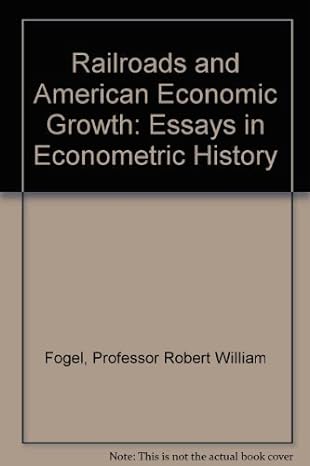 ] --- # "Getting to Denmark" .pull-left-wide[ ### Fukuyama’s idea - *Denmark* = shorthand for a **modern, inclusive, well‑governed society** (Fukuyam 2011 2015). - Achieving it requires a *trinity* 1. **State capacity** – the power to act 2. **Rule of law** – the power restrained 3. **Accountability** – the people’s voice - But how did *Denmark* get to Denmark? - Grundtvigianism and Creameries (and much more) ] -- .pull-right-narrow[ ### Short history - 1658, 1814, 1864: Denmark is reduced to a small insignificant state - 1848: First 'democratic' constitution - 1850-1900: Danish economic take-off (in part via rural industrialisation, Lampe and Sharp, 2019) - 1901, 1915: Democracy: System change (connected to Gr.) women's suffrage ] --- # Railways in Denmark .pull-left[ - First line opened between Roskilde and Copenhagen in 1847 - Many lines initiated in Fyn and Jutland by Petro, Brassey and Betts - Main lines operated as state lines in most of the relevant period ] .pull-right[ .panelset[ .panel[.panel-name[1847] 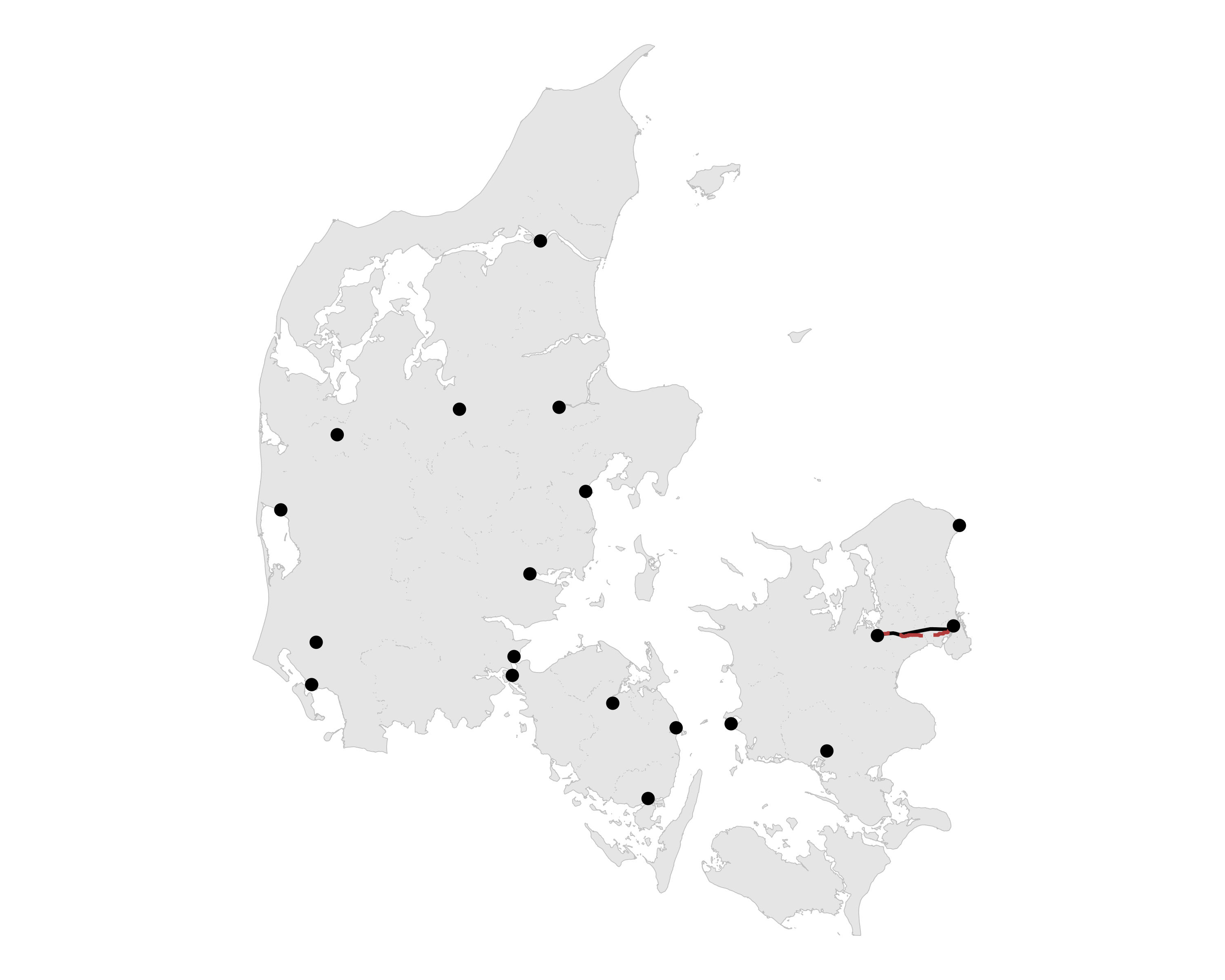 ] .panel[.panel-name[1860] 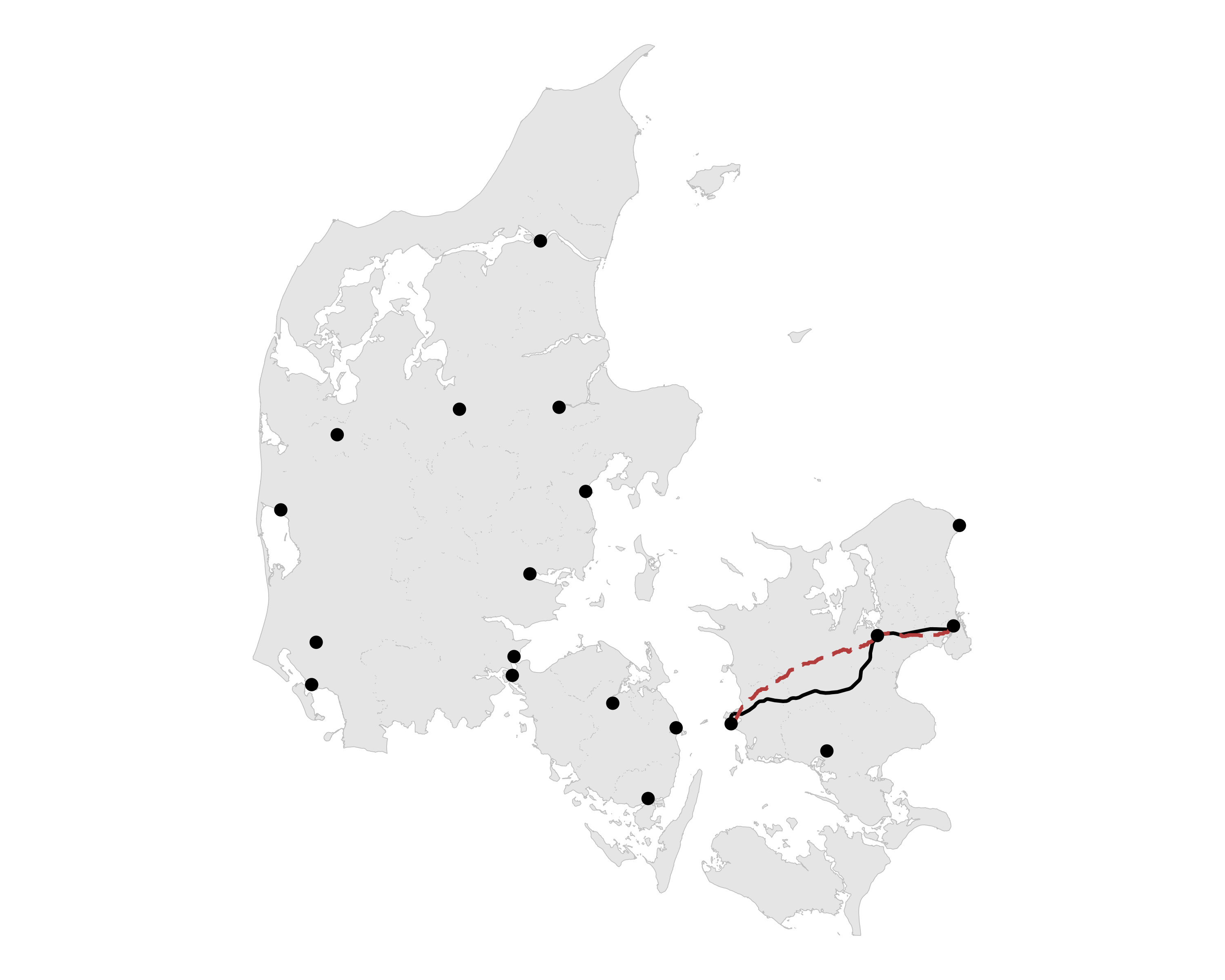 ] .panel[.panel-name[1880] 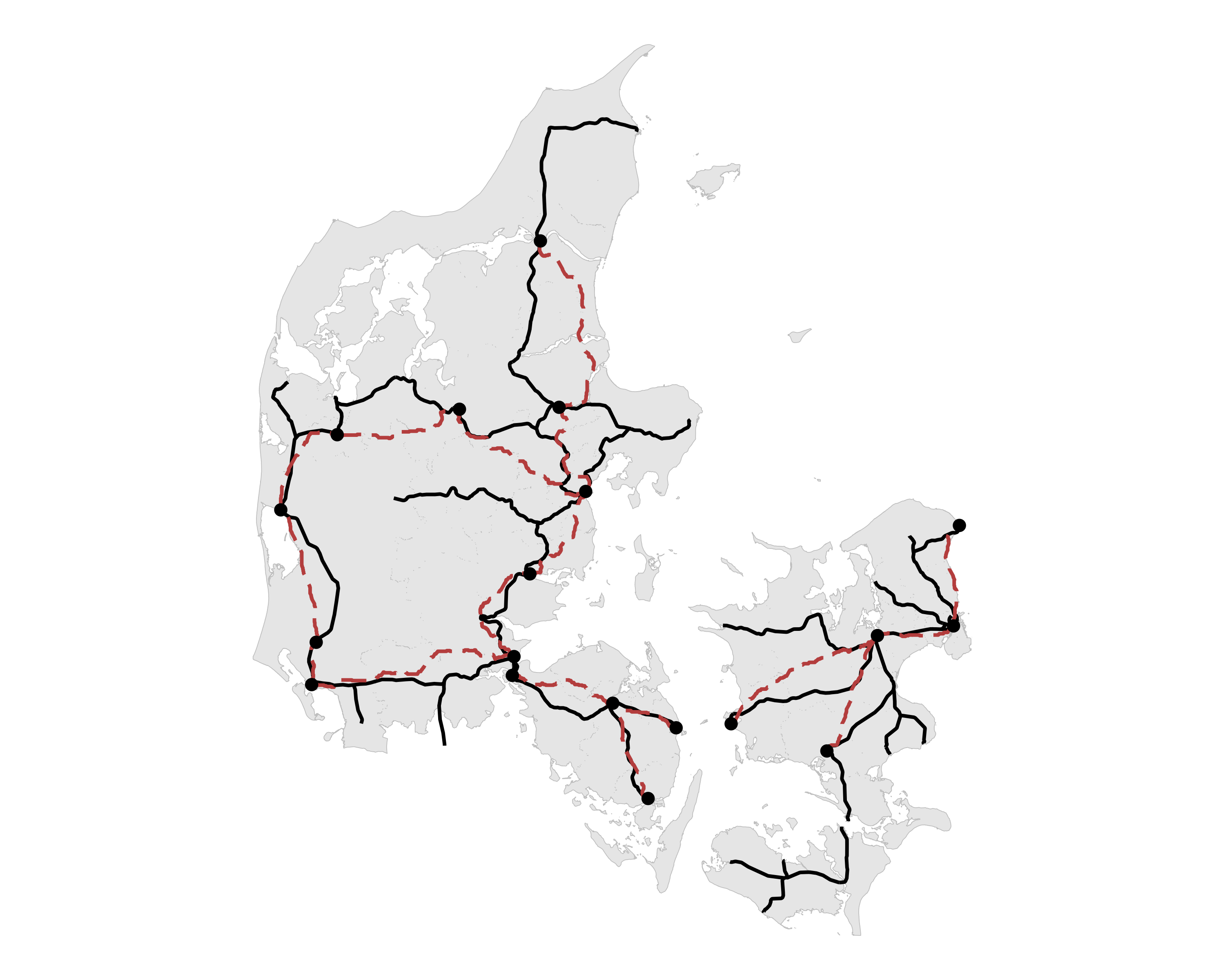 ] .panel[.panel-name[1901] 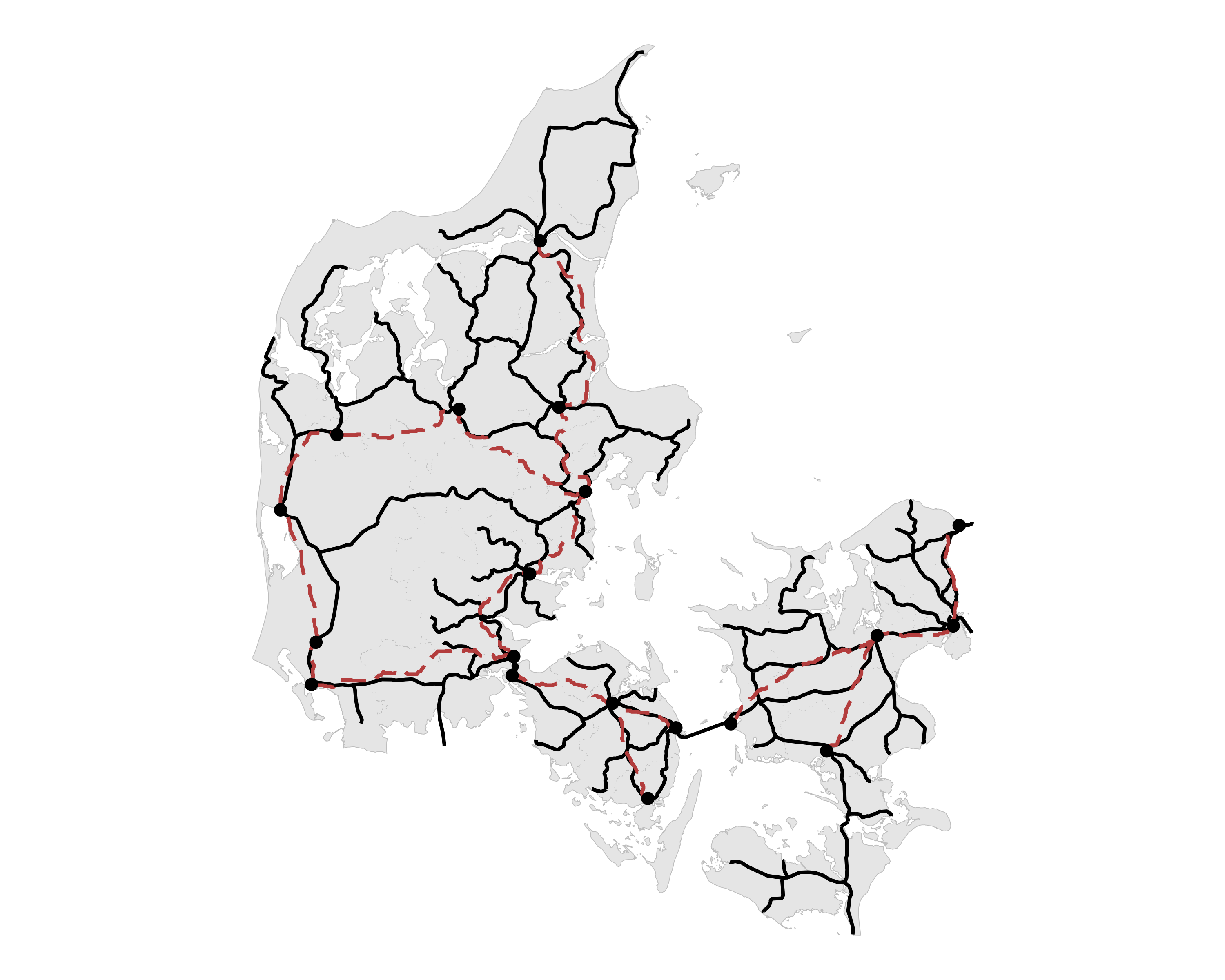 ] ] *Data from Fertner (2013)* ] --- # Grundtvig's alleged impact on prosperity .pull-left[ - Community Building: Social capital and trust, trustworthy institutions - Human capital - Cultural identity - Local democracy and societies - *"Leave two Danes in a room and they will form at least three societies"* <img src="Figures/Generalforsamling_i_Ansager_Andelsmejeri.jpg" width="80%" alt="Ansager"> .small123[*Agersnap, H. (1885) Generalforsamling i Ansager Andelsmejeri [wikimedia](https://commons.wikimedia.org/wiki/File:Generalforsamling_i_Ansager_Andelsmejeri.jpg)*] ] .pull-right[ .small123[ <img src="Figures/Grundtvig_wikimedia.jpg" width="75%" alt="Grundtvig"> C.A. Jensen (1843) 'Nikolaj Frederik Severin Grundtvig'. [Wikimedia commons](https://commons.wikimedia.org/wiki/File:N-f-s-grundtvig-portr%C3%A6t.jpg) ] ] --- # It's all about butter .pull-left-narrow[ - The Danish economic take-off follows the emergence of creameries - They produced butter exported to the UK - They required inputs - coal imported via railways - They required new organizational forms - Grundtvigianism ] .pull-right-wide[ .pull-right-wide[ 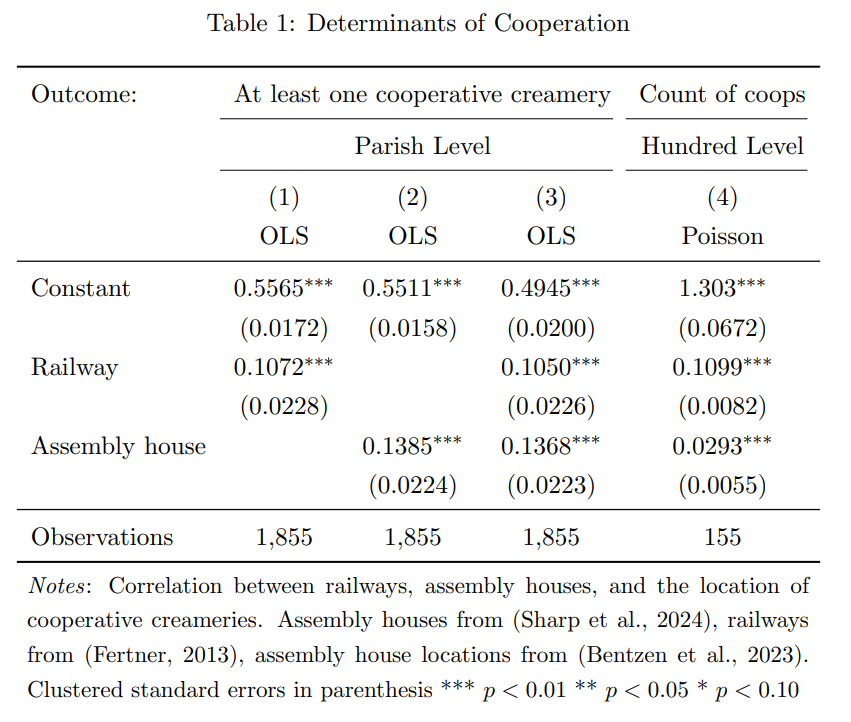 ] ] --- .pull-left-wide[ # Data - Census data 1787-1901 (Link lives) - HISCO codes for census descriptions (Dahl, Johansen, Vedel, 2024) - Linking with parish borders and consistency (Vedel, 2024) - Railroads shape files (Fertner 2013) - Location of assembly houses (Trap 3/4; Bentzen, Boberg-Fazlic, Sharp, Skovsgaard, Vedel, 2023) ] --- # Empricial strategy .pull-left[ - Difference in difference - **Identifying assumption:** + Places with railways would have had a parallel developmental path given the absence of railways ] .pull-right[ 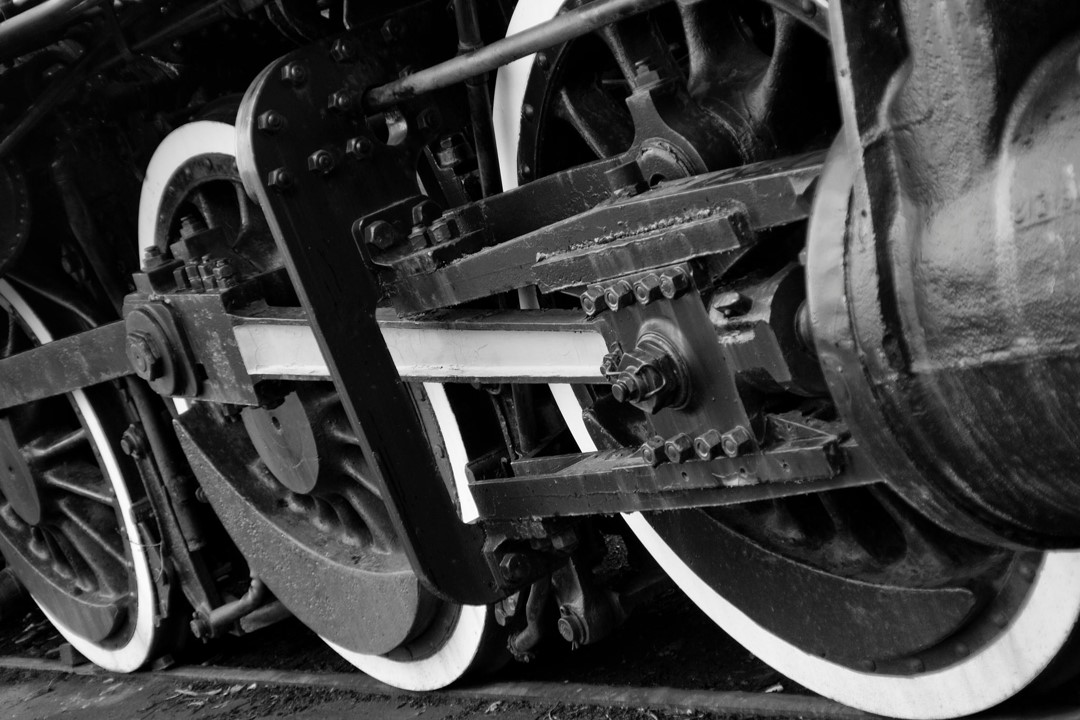 ] --- # Descriptive evidence .pull-left[ - Places connected to the railways saw more Grundtvigianism ] .pull-right[ 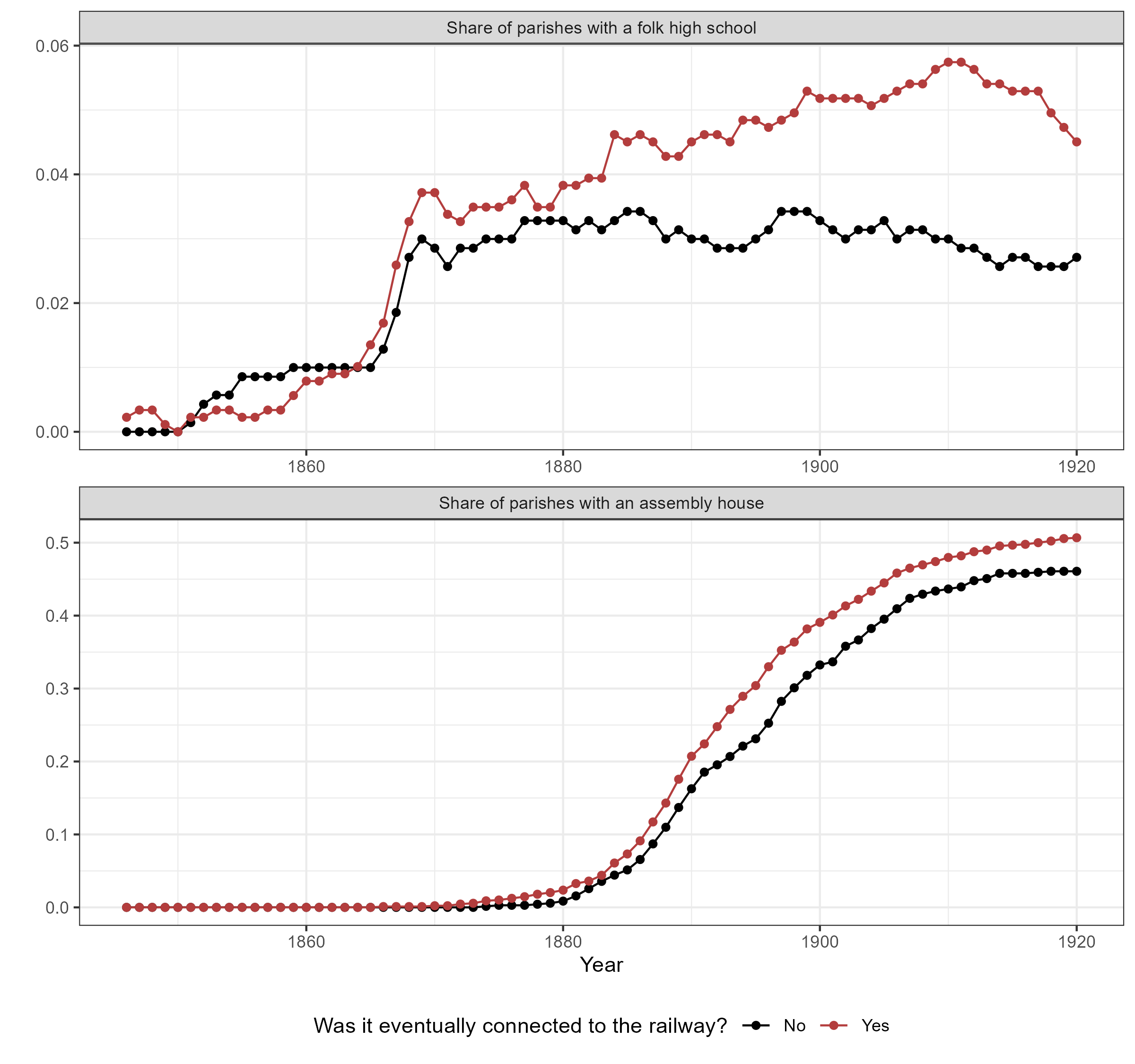 ] --- # Railways and the Economy .panelset[ .panel[.panel-name[Railways and the Economy] .small123[ | |(1) log(Pop) |(2) log(Child women ratio) |(3) log(Manufacturing 789) |(4) log(hisclass avg) |(5) log(Born different county) | |:-----------|:-----------|:-----------|:-----------|:-----------|:-----------| |Connected_rail |0.0652*** (0.0106) |0.0005 (0.0099) |0.1202*** (0.0193) |-0.0018 (0.0020) |0.1465*** (0.0410) | |GIS_ID FE |Yes |Yes |Yes |Yes |Yes | |Year FE |Yes |Yes |Yes |Yes |Yes | |Observations |6,374 |6,352 |6,357 |6,373 |6,282 | - Classical effect as expected - Still novel for the DK setting ] ] .panel[.panel-name[Railways and the Ideas (Grundtvig)] .small123[ |Dependent Var.: |(1) Assembly house |(2) log(MA assembly) |(3) High School |(4) log(MA High) | |:---------------|:-----------------|:----------------|:-----------------|:----------------| | | | | | | |Connected_rail |0.0560** (0.0185) |-0.0126 (0.0082) |0.0140** (0.0050) |0.0056 (0.0056) | |GIS_ID FE |Yes |Yes |Yes |Yes | |Year FE |Yes |Yes |Yes |Yes | |Observations |100,485 |102,245 |324,005 |324,005 | - Grudtvigian institutions specifically placed in connected places ] ] ] .footnote[ .small123[ **This also holds using the CS estimator* ] ] --- # Dynamics by year .panelset[ .panel[.panel-name[Population] .pull-right-wide[.pull-left-wide[ 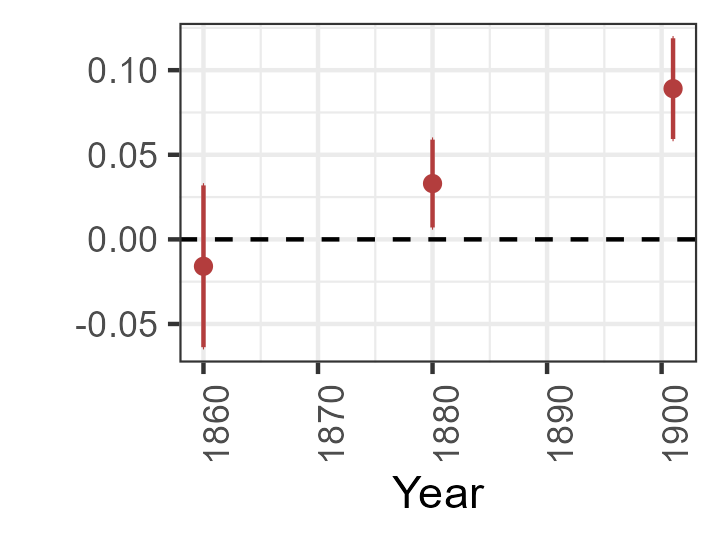 ]] ] .panel[.panel-name[Assembly houses] .pull-right-wide[.pull-left-wide[ 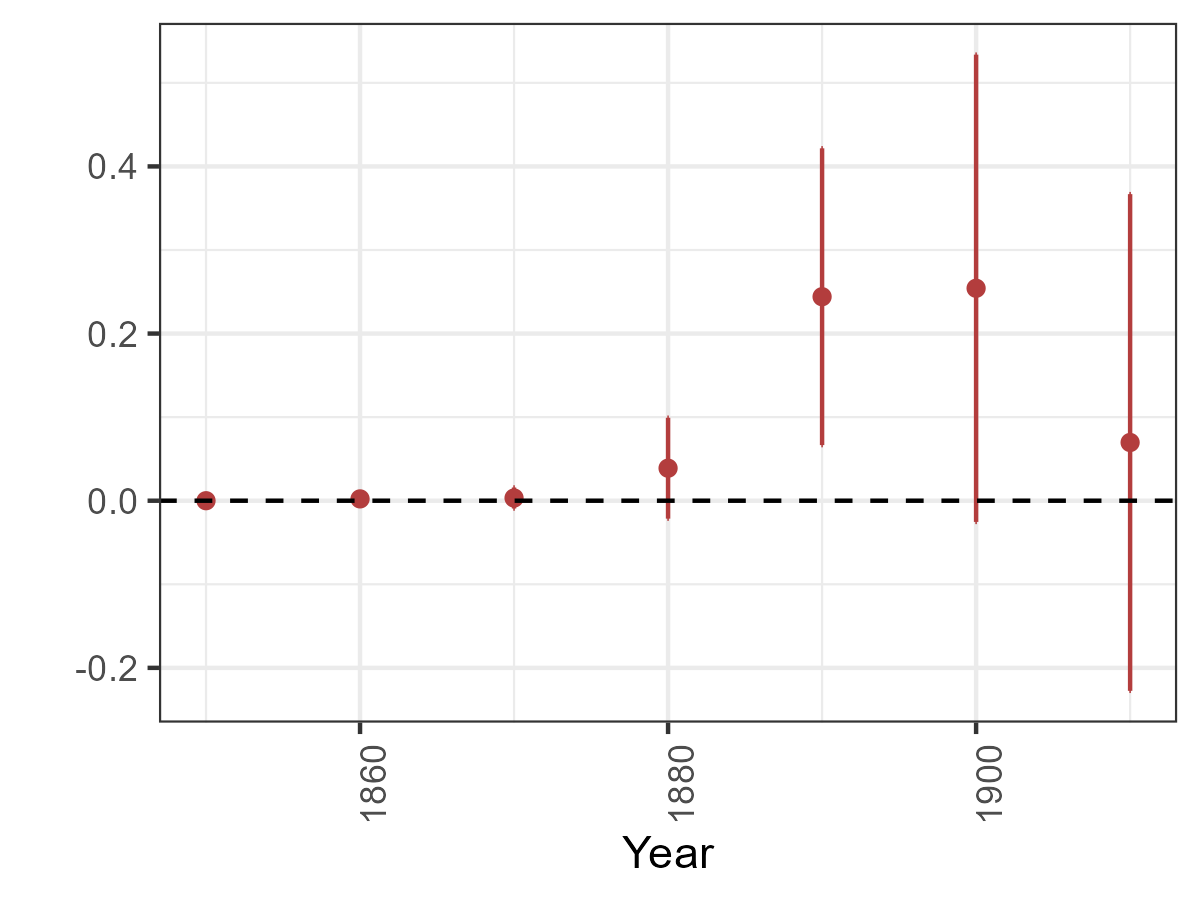 ]] ] .panel[.panel-name[Folk high schools] .pull-right-wide[.pull-left-wide[ 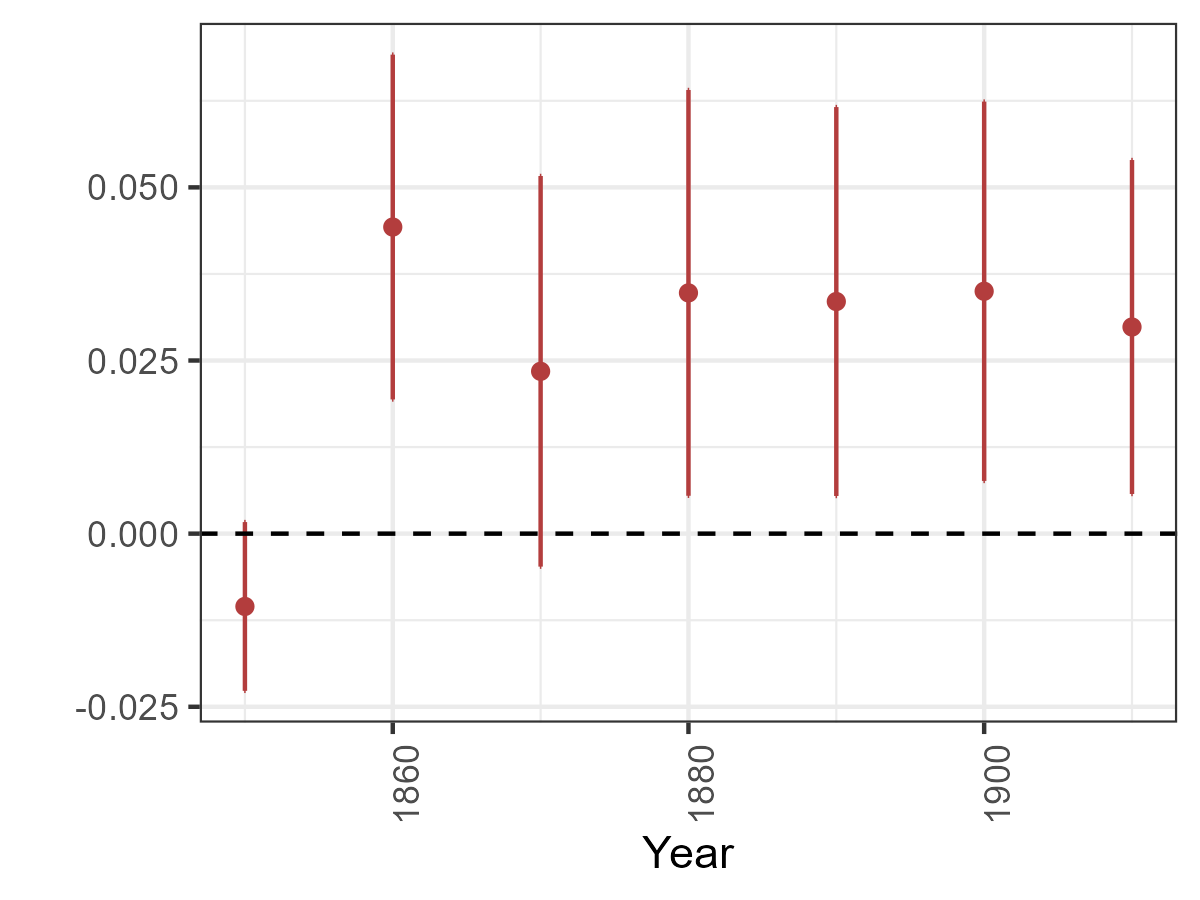 ]] ] ] --- class: middle # Conclusion .pull-left[ - We document that railways also had an impact on prosperity in Denmark - We add a new insight: Railways also spread the core ideas that led to modern Denmark **Feel free to reach out** ] .pull-right[ **Email:** <christian-vs@sam.sdu.dk>; **Twitter/X:** [@ChristianVedel](https://twitter.com/ChristianVedel); **BlueSky:** [@christianvedel.bsky.social](https://bsky.app/profile/christianvedel.bsky.social); **GitHub:** [github.com/christianvedels/Tracks_to_modernity](https://github.com/christianvedels/Tracks_to_modernity); **Paper:** [arxiv.org/abs/2502.21141](https://arxiv.org/abs/2502.21141) ]